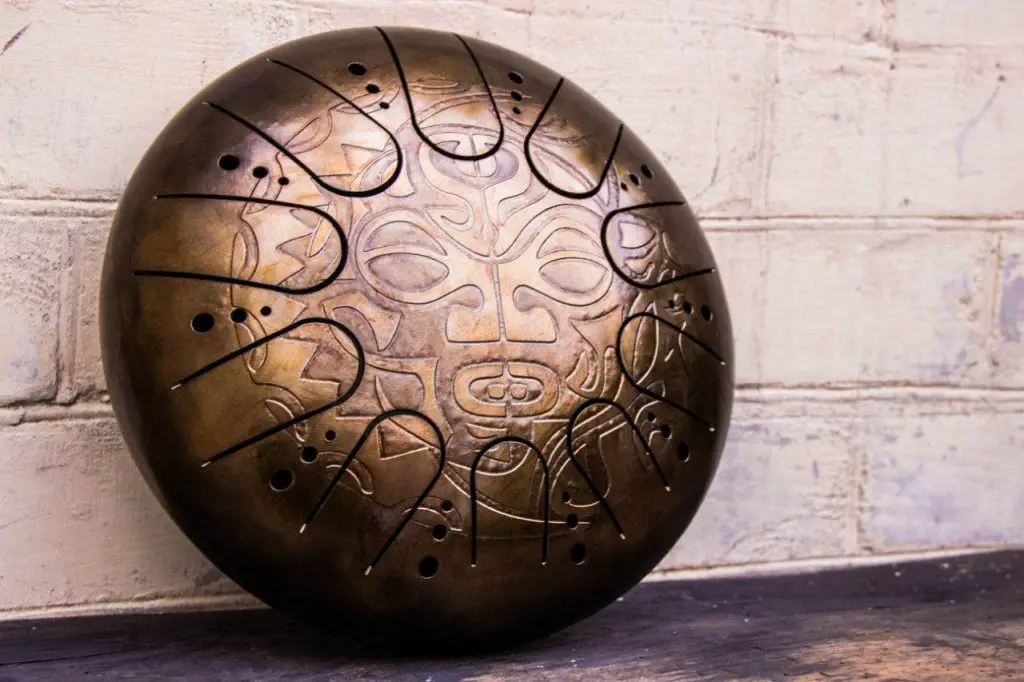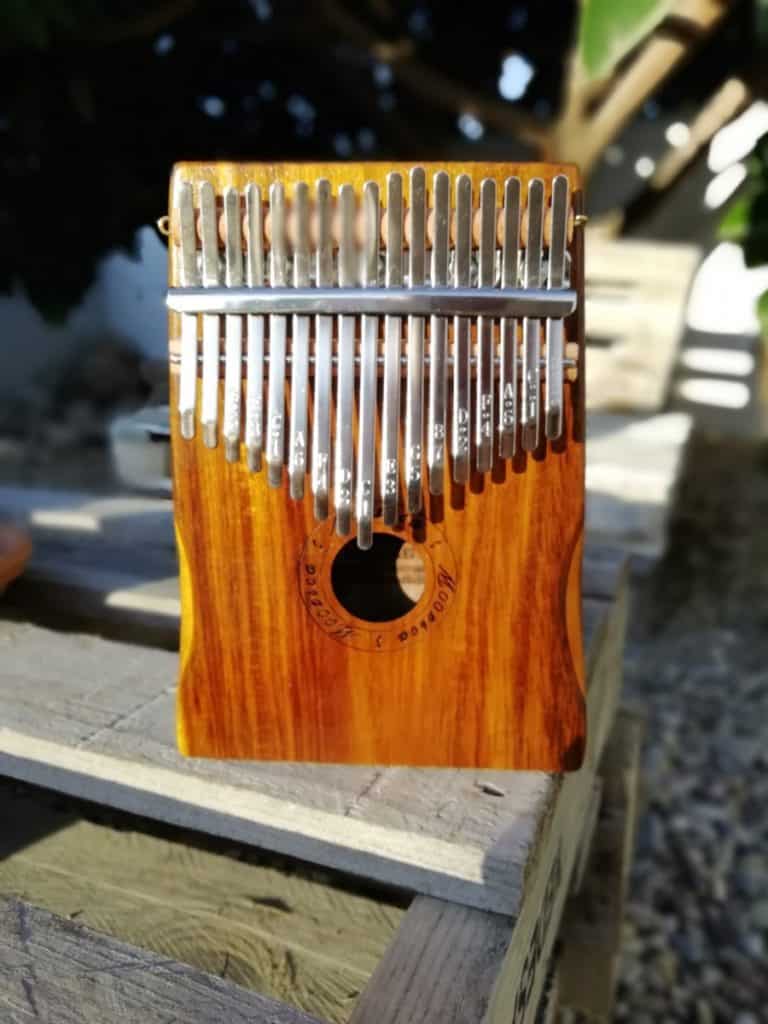Learn to Play Tongue Drum (5 Easy Steps)
This guide will provide some easy steps, hints, tips, and tricks to playing your new steel tongue drum, and getting the most from your new instrument
How to Play Steel Tongue Drum? – Both hands or mallets can play steel tongue drums. What you use often depends on the size, given tongue drums can come as small as 5.5 inches in diameter up to 20 inches for the Rav Vast models. Striking tongue-shaped grooves play notes in metal drums often constructed of propane gas tanks.
The Best Tongue Drum Course for Beginners & Intermediate Players
If you have just purchased a tongue drum or tank drum and can’t wait to start playing, a good friend of mine, Alex Connett, has a superb tank drum for beginners video course available at a super cheap price of $40.
Continue reading for more information
Easy Steps to Play Tongue Drum
When you pick up your tongue drum to play for the first time, there are a few fundamental things to do. Let’s not waste any time; you want to start striking those tongues and making sounds, right? That is the point of buying it!
So, here’s what I will cover
- Get Familiar with your instrument
- Mallets or Hands?
- Find the notes
- Experiment
- Tongue Drum Lessons
1. Get Familiar with your instrument
The package has arrived, the box has been unopened, and in front of you sits this little tank of wonder. A hunk of rounded metal with slits in the top, maybe colored, maybe painted.
Pick it up, get a feel for the weight, and let’s play.
First, you will need to position your tongue drum correctly. Being circular, it’s not immediately apparent, and there is NO correct way of placing it, but you will find to make things much easier, ensuring the lowest note is nearest your body will help.
By putting the lowest note nearest you, you will know that progressing up the notes, will be a simple left-right matter forward and around the drum.
Let’s call the lowest note, the largest tongue #1 – then working up the size of notes, in your mind consider the next #2, and the next #3 and so on.
Some tongue drums come with note stickers, usually numbered stickers you can place on the tongues to help identify them when you begin playing.
If you think they will help you remember, especially if there is also an instruction book with some basic tunes to play, then, by all means, add them. They will not affect the sound to a degree that will be detrimental.
If, however, you feel you can see and memorize where the 8 or more notes are, then have a go, you should be fine.
Check the tuning
When receiving your tongue drum, it should be tuned perfectly. If you have a good ear, you can play around the notes, progressing in pitch as you go and spot any notes that sound off. Again, if this is the case, you should check for visual damage, and if you are not happy with the tuning, have it returned and replaced with another drum.
Suppose you are not sure about the tuning. In that case, there are tuning apps available on mobile phones, or you can purchase inexpensive digital tuning devices on amazon, which will accurately inform you, by playing each note, if they are precisely on the pitch or slightly off.
Tunable Drums
There is one caveat to this tuning check and that is if you have a tunable tongue drum. In this case, it should be possible for you to get the tuning correct by slightly adjusting the magnets found on the backside of the drum through the access hole, wherever that may be positioned.
You can read my tunable tongue drum guide for more details and information on how to tune your tongue drum.
2. Play with Hands or Mallets?
Whether you play your tongue drum with your hands or with mallets will depend on a couple of things
- Size of Drum
- Sound required
- Level of Skill
Perhaps for beginners mallets would be the chosen route, and especially the case for the smaller varieties of tongue drums.
With some of the smaller, cheaper models popular with first time players as they try the tongue drum for the first time, mallets will be the easier choice too given the smaller tone field areas that need to be struck accurately.
Mallets Make Bigger Sounds
Mallets are harder than your fingers or thumbs, so they produce a louder sound when struck.
There is a range of mallets that can be used. They will have sticks shorter than you will see Timpani or Marimba players using, which is all relative to the size of the instruments.
Many tongue drums come with mallets and cases when purchased, and these mallets are OK to begin with. They tend to be quite hard plastic and you may want to buy slightly softer ones as you develop your skills.
Hands Produce Softer Tones
In the main, using your hands, thumbs, or fingers will produce a softer warmer tone when playing your tongue drum.
It may take a little longer to really get the feel of playing with hands, and it will take some practice, but there is no doubt that as you progress, you will be able to do a lot more.
There are many tips and tricks you can use playing with your hands. For a start, you have four fingers on each hand of which you can use the first finger or middle finger, or a combination, to tap or slap. You gave your thumbs. Most commonly the outside edge at the fist knuckle will be used to play the note.
You also have a range of knuckles that can be used, and you can use your fingers to produce rolls on the notes and affect the rhythms that you play too.
Using your hands gives you considerable versatility in the styles you can play, even on the smaller instruments, so it is worth practicing as much as possible with them.
The larger the tongue drum, the easier to play with your hands. Ultimately practice makes perfect, and with just 45 minutes a day for just 1 month, you will find you will become very good.
3. Find the Notes
So I have already mentioned the positioning of the tongue drum with the biggest note set closest to your body when you are ready to play, and you have had a little play with mallets and hands now. So it is time to find your notes and start playing some meaningful practice.
Playing tongue drum for beginners
There are some simple exercises you can use, either with mallets or hands, to begin finding your notes on an instinctive level.
Your tongue drum will be tuned to a scale. This scale is very conveniently constructed and you will find it hard to play a single note that sounds bad after the previous one.
So let’s start just by playing the scale in various ways.
Lowest to Highest
Starting at the lowest note [#1], play upwards through the scale in a rising fashion, 1, 2, 3, 4 etc. In many, this will be moving from the left to the right throughout the drum. But in any case, simply play, with one hand, each note in the order.
Now repeat that exercise using both hands so that you alternate hands for each note. Hearing each note in this order will help you not only hear the rising scale but also to begin to visualize the notes on the drum too
Now play each note in a clockwise fashion around the drum.
This is an ideal demonstration of how each of the notes in your scale works well with each other. Now play it anti-clockwise.
4. Experiment
This is where things get fun and you can start creating your own tunes. Even as a beginner
Play two notes together
You played each note with the mallets, or the hands, played them in ascending or descending order, and played around each note on the drum too.
You may have already noticed and identified a couple of notes that sound really nice together.
Play around the drum, picking two notes to play one after another to hear how they sound. Some will sound better than others, although none should sound bad when played in order.
You will have a preference for which two notes sound better than others, and you will remember them. You will almost certainly use these two notes together when you begin experimenting in putting more playing more notes in a rhythm as you create your first original melody
Playing your first Chord
I guarantee this tip is going to keep you amused for hours.
When you strike two or more notes at exactly the same time, you will be creating and playing a ‘chord’.
Chances are you have heard of chords, guitar players refer to them all the time. Well, hit any two notes at precisely the same time on your tongue drum and you have played a chord yourself.
How do I know which chords I am playing?
Yes. that is the very first question I asked myself when I first started playing these types of instruments. And do you know, right now, at this moment in time, it doesn’t matter.
It does matter because, whatever the name of the chord is, it doesn’t change how it sounds and how it makes you feel when you play it, and adding in extra confusion in trying to remember chord names will just confuse you further.
By all means, at a later date do some research and understand the various chords available on your scale, but for the time being, enjoy finding them.
Not all two notes will sound great together as a chord. Through trial and error, you can have fun trying out all the various combinations of two or three notes played together. There are a lot!
If you are dextrous enough to use your thumb and index finger on each hand to locate and play four notes simultaneously, the combinations rise again.
Whether you are playing a good-sounding chord or a bad-sounding one, you can identify these in your preference.
Try to remember those that you do like. Then play a few single notes, adding in the chord every now and then and hear how it fits into your composition.
5. Tongue Drum Lessons
I would not recommend lessons right from the start, but you can check out YouTube for some videos on tongue drums players providing some basic instruction.
Again, I would not rush into buying a course of lessons while you are still in the fun discovery stage,
At the point where you feel you want to be able to perhaps create and play a complete song, perform it for friends or family you could do with a little more guidance in making the whole thing perfect.
Or maybe you would like record and upload a video of yourself playing the tongue drum for Social media or start a YouTube channel, then you are going to want to hone your skills a bit further.
Subscribing to a beginner’s course of tongue drum lessons is going to push your skill level forward real quick but more importantly, it will prevent you from picking up self-taught bad habits that stick and slow your learning progress down.
I know myself from being self-taught on the guitar, I was using the wrong fingers often to play simple chords and had been doing so for years. I grew frustrated and not being able to play more challenging chords until I discovered that I had been using the incorrect fingers for a long time.
Trying to reteach myself to finger correctly was like going right back to the start, and I had to learn to play the guitar all over again.
Starting off using the right techniques, learning how to play rhythms and time signatures correctly from the start, will provide you with easy progress.
Below are some details of the best tongue drum beginners course.
The course is set out specifically on the Rav vast tongue drum but can apply to other tongue drums too
Tongue Drum Beginners Course
I would recommend taking up the video lessons course from MasterThe Handpan. Take a look at what it offers below.

There are over 50 video lessons in the course, which will take you right from the basics, in how to strike the notes and simple tricks for remembering things to, tips and tricks to creating great music and unique sounds on your instrument.
Simple short video lessons
Each lesson is provided in a short, digestible video, with clear instructions, slowly presented so you can play along. The convenience of the video lesson is you can see and hear what you should be doing from players perspective with video footage of the drum taken from overhead. So when you look at your drum, you are looking at exactly the same thing as the video and mimicking what the left and right hands are doing.
Learn at your Own Pace
You are not committed to turning out to a one to one lesson on a given time and date, you can choose where and when you fit in your next lesson at your convenience. There is no time limit to completing the course. Complete it at your own pace.
You Will Learn
- Coordination
- Using Alternate hands Naturally
- Some Simple Compositions to Play
- How to Play Chord and fit them in Melodies
- Rhythms
- How to Train your Ears
- And so much more to become a great tongue drum player.
The course begins with an introduction to your teacher David who has been teaching 1000’s of students to play handpan, Rav vast and Tongue drums for the last 10 years.
You work through the importance of warming up and exercise that will stand you in good stead for each time you play.
You will learn some basic rhythms to practice and master, before moving into coordination and hand independence.
More rhythms, playing arpeggios, chords, and melodies follow, and you blast through the course and start to really notice how great your playing sounds.
A bit of ear training precedes learning to ‘groove’ on your tongue drum. You’ll learn more compositions and how to create your own music.
You will own and have access to the video for always and be able to revisit any lessons that you find tricky, to master completely.
Related Tongue Drum Information
I have a host of other tongue drum articles to help you as you begin your tongue drum journey or wish to find out more before buying your first instrument.
Best Tongue Drums for Beginners
If you are still in the decision-making phase about which tongue drum to buy, I have a full guide to the best tongue drums for beginners.
Included are three types of tongue drums for different circumstances, including budget, kids and tunable instruments.
Steel Tongue Drum Guide
On overall guide on steel tongue drums for learning more general information about the tongue drum born out of the original tank drum invented by Dennis Havlena in 2007 included a brief history of its development.
Tongue Drums for Kids
Thinking of buying a tongue drum for children? An excellent choice ahead of things like the Xylophone which can a lot more learning before being able to play a tune.
The best tongue drums for kids guide will help you choose the perfect instrument for your child.
Tunable Tongue Drums
You can also purchase tongue drums that can be tuned to more than one scale. This tunable tongue drum guide provides information on how they work and a couple of recommendations for the easiest to retune and play.
My Favourite Stuff
These are a few of my favorite things including items covered by the subject of this page. All items are personally owned by me, [I have bought them all] and come with the recommendation based on my personal use not just a quick sale affiliate pitch.
Kosmosky Tank Drum

Kosmosky is my favorite tank drum which you can buy direct from the shop.
Priced between $269 to $490 be assured you are buying one of the best Tank drums available in the World saving at least $200 on the Rav Vast
Cheap Tongue Drum Course for Beginners
My good friend Alex has produced this superb video course on how to play Tongue Drum.
Using a Kosmosky tank drum to take you through the basics, there is a follow-up course too when you become more advanced.
The Rav Vast Range
The Rav Vast Tongue Pans are unique in size and sound and start at around $700.
An excellent introductory alternative for people not quite prepared to spend $2000 on a handpan.
Or an upgrade from Tongue drums like Kosmosky
Moozika Kalimba
Kalimbas are awesome and I own about 8 right now, but if you have come across my website looking for Kalimba information, then I will recommend this cheap and easy to buy Kalimba available on Amazon as something to get started on.
In fact it will last you as long as you are learning the instrument.
At around forty bucks, it’s not a bank breaker either.







![Best Percussion Instruments For Kids [That you can play too]](https://cdn-0.coolpercussion.com/wp-content/uploads/2020/09/woman-4010110_1920-768x512.jpg)

